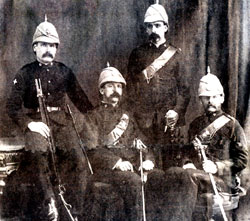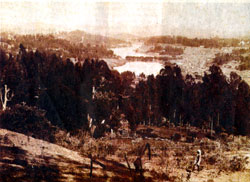It
was
the accident discovery of a letter that led Christoper penn to
reclaim his fascinating ancestral past. Rummaging in the back
of a writing bureau in his surrey home three years ago, he discovered
a letter that had got wedged in the shelving. It was written to
his father, Who had died twelve years earlier, by a Patricia Manders.
The letter Identified her as his father’s cousin. Christoper
had never heared of the lady, but that wasn’t surprising.
His father never spoke about his side of the family to his children.“
It’s almost as if they never existed,” says Christoper.
“I suspect this was because my grandfather, Harold Penn,
had….ummm….a somewhat colourful life.
|
Voyage
of Discovery
|
 The
letter launched his on a voyage of discovery. He wrote to Manders
and, a few days latter, received a phone call from her with the
invitation: “why don’t you come and visit me in Weston-Super-Mare?”
It was when he met Manders that he discovered that his great grandfather
– Albert Thomas Watson Penn (1849-1924) – was a leading
and extremely accomplished photographer based in Ootacamund. A
second meeting with Manders, and two other cousins, produced an
obituary of Albert Penn that was published in the South India
Observer. The
letter launched his on a voyage of discovery. He wrote to Manders
and, a few days latter, received a phone call from her with the
invitation: “why don’t you come and visit me in Weston-Super-Mare?”
It was when he met Manders that he discovered that his great grandfather
– Albert Thomas Watson Penn (1849-1924) – was a leading
and extremely accomplished photographer based in Ootacamund. A
second meeting with Manders, and two other cousins, produced an
obituary of Albert Penn that was published in the South India
Observer.
The information came in trickles. A visit to a London antiquarian
turned up a first edition of Edgar Thurston’s “Castes
and Tribes of South India”, which carried Penn’s pictures
on the Todas, Badagas and Kurumbas. More pictures emerged when
Christopher located another first edition of Frederick Price’s
“Ootacumund: A History” . Christopher paid ‘obscene’
sums for books, but Albert Penn was beginning to acquire a certain
form and character.
“ By then, I was bitten by the bug. I simply had to know
more,” say Christopher, a retired high ranking executive
with Pearson Plc, the publishing group that owns Penguin among
other interests. In 2002, Christopher set out from England to
Ooty with his wife Mary and two relatives. He knew that Albert
Penn was buried at Coonoor’s Tiger Hill cemetery, but it
was shuffling through the church records at Ooty’s St. Stephen’s
which revealed he was married there in 1870 to a woman from Eagan
family, which owned an emporium and a hotel. Albert had come to
India about five or six years earlier as a young lad of 16 and
set up his business as a photographer in Ooty. In the early years,
he would move to the winter months (“where work was more
plentiful,” reckons Christopher), but it was in Ooty where
he established his reputation as a leading photographer shooting
people, landscapes and events such as weddings or the annual meet
of the Ootacumund Hunt.
He left a record of the local tribes, particularly the Todas.
“What distinguishes his portraits from other is the sympathy
and respect with which he appears to hold the sitter. They are
careful compositions and not simply ethnographic studies,”
observes Christopher. An extraordinary collection of pictures
of children was published by the missionary Amy Carmichael in
her book “Lotus Buds” in 1909. Albert traveled from
Ooty to Tirunelveli for the project commissioned by Carmichael,
who noted that the pictures are “much better than we dared
to except” even though the photographer was more accustomed
to the dignified ways of mountains than to the extremely restless
habit of children; and he never could understand why they would
not sit for him as the mountains sat, and let him focus on them
comfortably.”
 Christopher
is interested when told that Amy Carmichael was a passionate environmentalist
even before the terms was invented and that the records of wildlife
sighting kept by her Dohnavur Trust formed the body of material
that helped convert the forests at kalakkad in to a sanctuary
to preserve the lion-tailed macaque. “Is there a picture
of her?” He asks. “I wonder why he traveled so many
miles, taking with him the bulky photographic equipment of the
time, for this assignment.” Christopher
is interested when told that Amy Carmichael was a passionate environmentalist
even before the terms was invented and that the records of wildlife
sighting kept by her Dohnavur Trust formed the body of material
that helped convert the forests at kalakkad in to a sanctuary
to preserve the lion-tailed macaque. “Is there a picture
of her?” He asks. “I wonder why he traveled so many
miles, taking with him the bulky photographic equipment of the
time, for this assignment.”
Back in India to visit Ooty and Chennai for a third time, Christopher
is aware that information related to his project can turn up most
unexpectedly. For instance, he found that great grandfather’s
Cranley cottage and the adjacent building which housed his “Photographic
Gallery” still exist and are now used as the office of a
business family. The Ootacumund Club, of which Albert was the
‘court photographer’ hadn’t heard of him. But
Christopher found two signed photographer up on the walls after
he was allowed to walk around and have a ‘dekko’. |
Flamboyant
Character |
 Inevitably,
researching great grandfather threw up facts about grandfather
Harold - the man who Christopher’s father was too embarrassed
to speak about. A flamboyant character, Harold was awarded the
distinguished Conduct Medal for the cavalry charge at Omdurman
in Sudan and served in the 21th Hussars (renamed the Lancers)
in India. He won a small fortune in the Calcutta Derby, but died
in penury after a messy divorce and a troubled life. Inevitably,
researching great grandfather threw up facts about grandfather
Harold - the man who Christopher’s father was too embarrassed
to speak about. A flamboyant character, Harold was awarded the
distinguished Conduct Medal for the cavalry charge at Omdurman
in Sudan and served in the 21th Hussars (renamed the Lancers)
in India. He won a small fortune in the Calcutta Derby, but died
in penury after a messy divorce and a troubled life.
The information Christopher has collected led him to build a family
tree one hundred and twenty one direct descendants of Albert Penn
survive and Christopher invited them all to his Surrey home for
a party. “Only fifty eight were able to come. But it was
fun,” he says. His aim is to research his great grandfather’s
life and create a comprehensive catalogue of his work. Dose he
plan to spin this out in to a book? “Well, I am not sure
I have enough material on it yet,” he says. “But I
am not ruling it out.” |
|
|